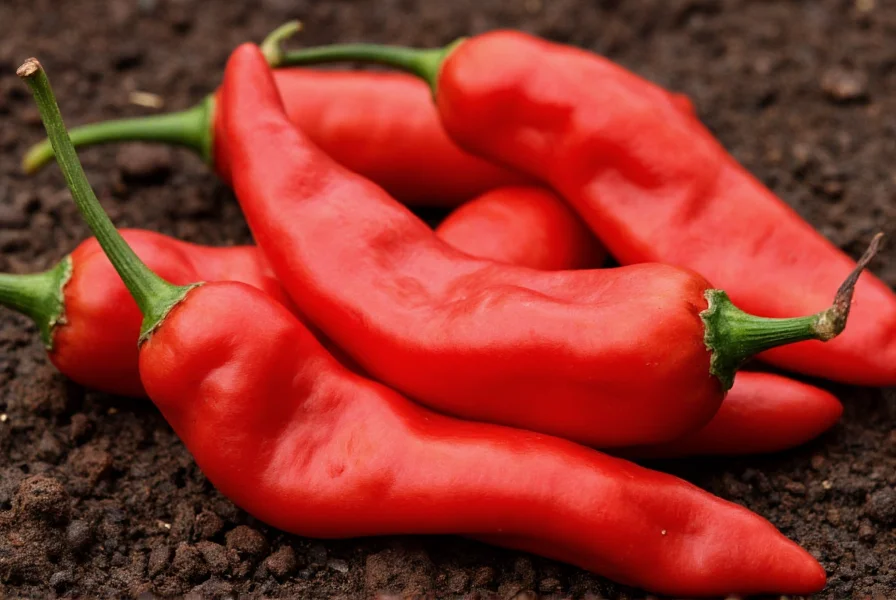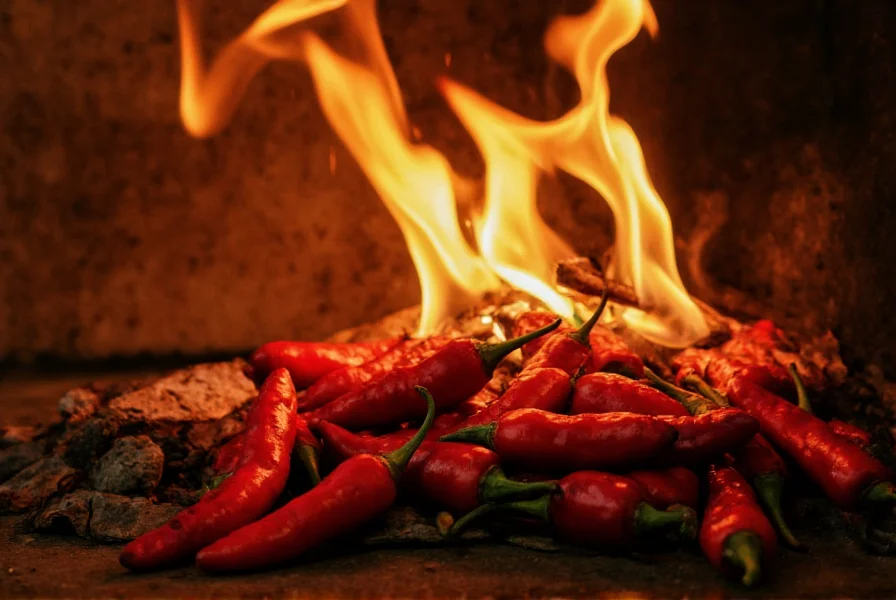When exploring the world of super-hot peppers, rock pepper fire stands out as one of the most intense options available to culinary enthusiasts and heat seekers. Unlike common jalapeños (2,500-8,000 SHU) or even habaneros (100,000-350,000 SHU), rock pepper fire belongs to the elite category of peppers that test the limits of human heat tolerance.
Understanding Rock Pepper Fire's Heat Profile
The term "rock pepper fire" typically describes peppers that have been selectively bred for maximum capsaicin content, the compound responsible for chili heat. While not an officially recognized botanical classification, this descriptor has gained popularity among pepper growers and culinary professionals seeking extreme heat experiences.
Peppers falling under the "rock pepper fire" category generally register between 1.2-2.2 million SHU on the Scoville scale. To put this in perspective, you would need to consume approximately 200 times more bell pepper to match the heat of just one unit of rock pepper fire.
| Pepper Variety | Scoville Heat Units | Heat Comparison |
|---|---|---|
| Rock Pepper Fire | 1,200,000-2,200,000 | Extreme |
| Carolina Reaper | 1,400,000-2,200,000 | Extreme |
| Trinidad Moruga Scorpion | 1,200,000-2,000,000 | Extreme |
| Habanero | 100,000-350,000 | Very Hot |
| Jalapeño | 2,500-8,000 | Medium |
Origins and Development
Rock pepper fire peppers emerged from selective breeding programs focused on pushing the boundaries of chili heat. Most specimens classified under this term trace their lineage to Capsicum chinense varieties, particularly those developed from the Naga and Bhut Jolokia (ghost pepper) bloodlines.
Unlike naturally occurring peppers, rock pepper fire varieties are typically the result of careful cross-pollination between already extremely hot cultivars. Growers select parent plants with the highest heat measurements, creating subsequent generations with increasingly intense capsaicin concentrations. This breeding process explains why rock pepper fire isn't a single standardized variety but rather a category of peppers sharing similar extreme heat characteristics.

Culinary Applications of Extreme Heat Peppers
Professional chefs and home cooks use rock pepper fire with extreme caution due to its overwhelming heat potential. The key to successfully incorporating this super-hot pepper lies in understanding its proper usage techniques:
- Minimal quantities - A single drop of infused oil or a tiny flake of dried pepper often suffices for an entire dish
- Delayed addition - Add near the end of cooking to preserve volatile heat compounds
- Infusion methods - Creating oils or vinegars allows controlled heat distribution
- Acid balancing - Citrus or vinegar can help moderate perceived heat
When used appropriately, rock pepper fire contributes more than just heat—it adds complex fruity undertones reminiscent of berries and citrus that sophisticated palates can detect beneath the intense burn. This nuanced flavor profile distinguishes high-quality specimens from lesser super-hots that offer only one-dimensional heat.
Safety Considerations for Handling Rock Pepper Fire
Working with rock pepper fire requires serious safety precautions that many novice chili enthusiasts overlook. The capsaicin concentration in these peppers can cause severe irritation well beyond typical kitchen discomfort.
Essential safety measures include:
- Wearing nitrile gloves (latex provides insufficient protection)
- Using protective eyewear to prevent accidental transfer to eyes
- Working in well-ventilated areas or using fume hoods for processing
- Avoiding contact with skin, especially sensitive areas
- Having dairy products (milk, yogurt) readily available to neutralize accidental exposure
Medical professionals warn that improper handling of rock pepper fire can lead to second-degree chemical burns, temporary vision impairment, and respiratory distress. Emergency rooms have reported cases of individuals requiring medical attention after inadequate protection during super-hot pepper preparation.

Purchasing and Storage Guidelines
When sourcing rock pepper fire products, consumers should look for reputable suppliers who provide verified Scoville ratings and proper handling instructions. The market contains many mislabeled products that don't deliver the promised heat levels or safety information.
Proper storage extends the potency and shelf life of rock pepper fire:
- Fresh peppers maintain maximum heat for 2-3 weeks when refrigerated in perforated bags
- Dried peppers retain potency for 6-12 months in airtight containers away from light
- Freezing whole peppers preserves heat compounds for up to 1 year
- Pepper-infused oils should be refrigerated and used within 1 month for safety
For those seeking authentic rock pepper fire experiences, connecting with specialty chili growers' associations provides access to verified varieties and expert usage advice. These organizations often maintain databases of certified super-hot pepper producers who adhere to strict quality and safety standards.
Responsible Consumption Practices
Chili heat challenges involving rock pepper fire have gained popularity online, but medical professionals strongly advise against consuming these peppers in their pure form. The extreme capsaicin concentration can trigger:
- Severe gastrointestinal distress
- Temporary blood pressure spikes
- Respiratory complications
- Throat swelling in sensitive individuals
Culinary experts recommend starting with minuscule amounts diluted in carrier substances like oil or honey, gradually building tolerance over weeks or months. Even experienced heat seekers typically limit rock pepper fire usage to accentuating specific dishes rather than making it the primary flavor component.
Frequently Asked Questions
What exactly is rock pepper fire and how does it differ from regular hot peppers?
Rock pepper fire refers to an extremely hot chili pepper variety or preparation that typically measures over 1 million Scoville Heat Units. Unlike regular hot peppers like jalapeños (2,500-8,000 SHU) or habaneros (100,000-350,000 SHU), rock pepper fire belongs to the super-hot category that requires careful handling and minimal usage due to its intense capsaicin concentration.
How should I safely handle rock pepper fire peppers in my kitchen?
When handling rock pepper fire, always wear nitrile gloves and protective eyewear, work in a well-ventilated area, and avoid touching your face. Have dairy products like milk or yogurt nearby to neutralize accidental exposure. Never use bare hands, and thoroughly clean all surfaces and tools after preparation to prevent cross-contamination.
Can rock pepper fire be used in everyday cooking or is it only for extreme heat challenges?
Rock pepper fire has legitimate culinary applications beyond heat challenges. Professional chefs use it sparingly to add complex heat and subtle fruity notes to sauces, stews, and specialty dishes. The key is using minuscule amounts—often just a flake of dried pepper or a drop of infused oil per dish—to enhance rather than overwhelm the flavor profile.
What should I do if I experience discomfort after handling or consuming rock pepper fire?
If you experience skin irritation, immediately wash the affected area with soap and cold water, then apply milk or yogurt to neutralize the capsaicin. For mouth burns, consume dairy products like milk or ice cream. If you experience severe symptoms like difficulty breathing, persistent pain, or vision problems, seek medical attention immediately as these could indicate a serious reaction requiring professional treatment.
How can I verify if a rock pepper fire product is authentic and properly rated for heat?
Look for products from reputable specialty chili growers that provide third-party verified Scoville ratings. Authentic suppliers will include detailed handling instructions and origin information. Be wary of products making extraordinary heat claims without documentation, as the market contains many mislabeled items. Connecting with chili enthusiast communities or specialty food associations can help identify trustworthy sources for genuine rock pepper fire products.











 浙公网安备
33010002000092号
浙公网安备
33010002000092号 浙B2-20120091-4
浙B2-20120091-4